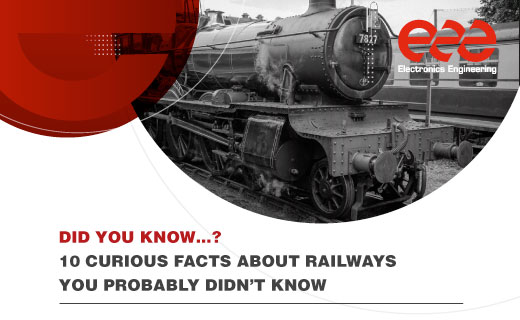Railway Facts and Curiosities You Probably Didn’t Know
Railways are one of the world’s oldest, most efficient, and transformative modes of transport. But even those who work in the industry might be surprised by some of its lesser-known facts.
Here are 10 railway curiosities that might just change the way you look at trains, even if you’re a professional in the field.
- The longest train in history stretched over 7 kilometers
In 2001, a mining company in Australia operated a 7.3 km-long train made up of 682 coaches and 8 locomotives. Its mission: to transport 82,000 tonnes of iron ore.
This extreme logistics test demonstrated just how far railway engineering can go.
- Some stations have no exit
Certain stations in countries like Japan or Switzerland have no direct access to the outside world. Located in tunnels or remote areas, they are used only for evacuations, maintenance, or technical purposes.
One example is Japan’s Doai Station, known for its exit via a staircase of 486 steps.
- The world’s fastest train… levitates
Japan’s magnetic levitation (maglev) train has reached speeds of 603 km/h during tests.
Because it doesn’t touch the tracks, friction is eliminated, allowing for record-breaking speeds. While it’s not yet in full commercial operation, it represents the future of high-speed rail.
- Some trains cross multiple time zones
The Trans-Siberian Railway, for instance, travels nearly 9,300 km from Moscow to Vladivostok, crossing seven time zones.
Passengers can witness several “sunrises” in one journey, depending on the length of the trip.
- Railways were the first transport system to use electric signalling
In the 19th century, long before cars or planes, trains were already using telegraph signals to manage traffic.
This was a revolutionary step in safety and laid the foundation for today’s control systems.
- Some stations have over 40 platforms
New York’s Grand Central Terminal has 44 platforms and 67 tracks, making it the world’s largest station by number of platforms.
A clear example of how railway infrastructure can reach urban-scale proportions.
- Some trains run on batteries
In regions where track electrification is too expensive or complex, such as short routes or rural areas, battery-powered trains are gaining ground.
It’s a sustainable and silent solution already being implemented in countries like Germany and Norway.
- Some panoramic trains have glass ceilings
Switzerland’s Glacier Express is famous for its panoramic coaches with transparent roofs.
The 8-hour journey through the Alps runs at low speed, allowing passengers to enjoy breathtaking scenery… without leaving their seats.
- “Ghost trains” run with no passengers
Some operators must maintain minimal service on certain routes to retain access rights or comply with regulations.
These nearly empty trains, known as ghost trains, run at unusual hours as part of a legal or logistical requirement.
- Rail is the safest form of land transport
Rail has a significantly lower accident rate than road transport.
Much of this is thanks to technologies such as SIL (Safety Integrity Level) systems, which ensure the reliability of the most critical components.
At Triple E, where safety and innovation are at the core of what we do, we also enjoy exploring the more curious side of railways.
Because understanding the history, anecdotes, and technical milestones of this sector is another way of celebrating a field that keeps moving forward on rails.










